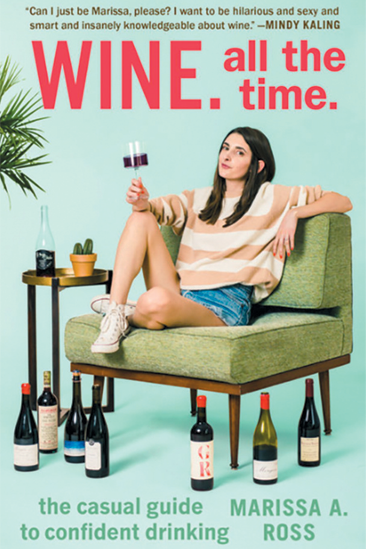Edible Reads for Spring
Two new books for your spring reading list.
Out of Line: A Life of Playing with Fire
(Atria Books, 2017) by Barbara Lynch
Barbara Lynch’s memoir reads like a film script. She grew up in the same Boston neighborhood as infamous mob boss Whitey Bulger. She began her first job at 13 years old, cooking for priests in a nearby rectory. She took vacations to Bermuda paid for by stolen credit cards, siphoning gas to fuel mopeds and creating elaborate ruses to steal booze. Despite her colorful background—and, maybe, because of it—Lynch has built a restaurant empire in Boston. She now owns seven restaurants, employs more than 200 people and boasts profits that reach into the tens of millions. Time Magazine named her one of the most influential people of 2017; she is one of six Grand Chefs in the U.S. as named by Relais & Châteaux and the James Beard Foundation lauded her as an outstanding restaurateur in 2014—an accolade awarded to only one other woman. Her chaotic upbringing—she grew up as the youngest of seven children raised by a widowed mother—meant that she had to be cunning enough to fend for herself. Before the first chapter ends, Lynch describes being raped when she was 7 years old.
Through dogged determination and sheer talent, she taught herself how to cook and thrive in professional kitchens. She snagged a job cooking on a cruise ship and turned that gig into one working for acclaimed chef Todd English before eventually focusing on opening her own restaurants. “It struck me that, along the way, the process of cooking—its movements and rhythms—felt perfectly natural and instinctual, like something I was born to do,” Lynch writes, referring to an epiphany after being abruptly thrust into the head chef position on a small cruise ship. Though there has been a glut of chef memoirs in the last several years, Lynch sets herself apart with her storytelling ability. Her writing is entertaining and often funny, but it’s also concise, clear and loaded with details. It reads like a combination of Anthony Bourdain’s Kitchen Confidential and Gabrielle Hamilton’s memoir Blood, Bones and Butter.
Recalling her mother’s tuna sandwiches, Lynch writes, “She’d only use Starkist white albacore in water and Cains mayonnaise, never Hellman’s, thinned with splashes of milk and a secret ingredient, Vlasic pickle juice. She’d shred the mixture with two forks until it was creamy, spoon it onto Sunbeam, not Wonder Bread (which had too many holes), and top it with pickle slices.”
Lynch’s underdog story is hard not to root for, particularly with her reputation as a generous mentor to young chefs and her tireless work ethic.
— Kevin Huelsmann
Wine. All the Time. The Casual Guide to Confident Drinking
(Plume, 2017) By Marissa A. Ross
Marissa A. Ross, wine blogger and columnist for Bon Appétit, brings a wrecking ball to the edifice of wine snobbery. A former comedy writer, hip yet self-effacing, Ross’s aim is to furnish her reader with a simple skills set to demystify the process of selecting, and encourage buying, the “unknown wine.” Despite the comedic tone and sometimes over the- top imagery in her writing, her mission to create “informed drinkers” underpins every section and sentence. In 10 packed chapters, the author shares her passions, unpacks her prejudices and irreverently fulfills the promise of her “Disclaimer: This is a lighthearted primer for the wine consumer….” Ross devotes much of the book to decoding: the essence of famed regions, the mystery of the label and the meaning of classifications. Her advice for buying, bringing and sharing wines includes suggestions for “Hippie Sisters,” “Hang Sesh with a New Friend” and “For Super Religious Aunts.”
Her journey from Franzia White Zin to Cab Franc reflects the experience of many wine lovers who start simply and build up their palates from there. Ross asks and answers questions neatly. Ever wondered what are orange wines? ey are white wines made like reds. Or how many glasses are in those huge bottles reverently stored on restaurant shelves? A magnum equals two bottles or 10 glasses; jeroboam, six bottles or 40 glasses; all the way to Nebuchadnezzar, 16 bottles containing 100 glasses.
Her descriptions of terms are also clever and helpful: Extra brut is “dry as hell” and demi-sec, “pretty damn sweet.” She also gives sound advice to help advance your palate: Try buying the same varietal in two versions, one oaked and the other unoaked, and compare.
For those confused about organic, natural, sustainable and biodynamic wine, she devotes a chapter to these movements and hurls a few stones at mass-marketed and industrially produced commercial wines.
She gives opinions on stemware, party planning and even a hangover cure. Leavened with information on tasting, varietals and a canny glossary placed at the beginning rather than at the end, Ross’s book, though laced with R-rated language, is alive with useful ideas for almost anything related to wine drinking.
Marissa A. Ross has written a guide for the rest of us that is smart, focused and witty. A plain-talking wine aficionado, she practices what she preaches and knows whereof she speaks.
—Alan Minskoff





